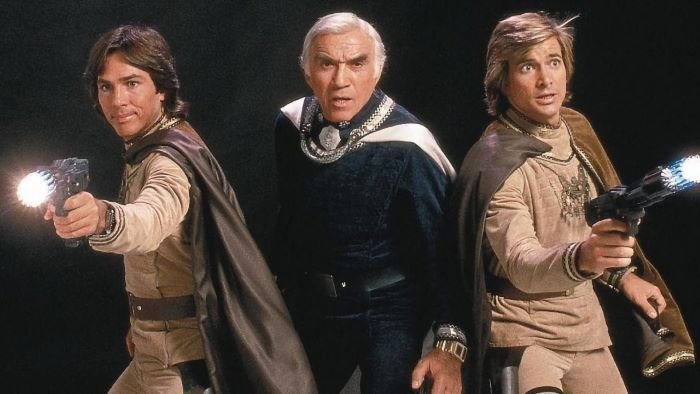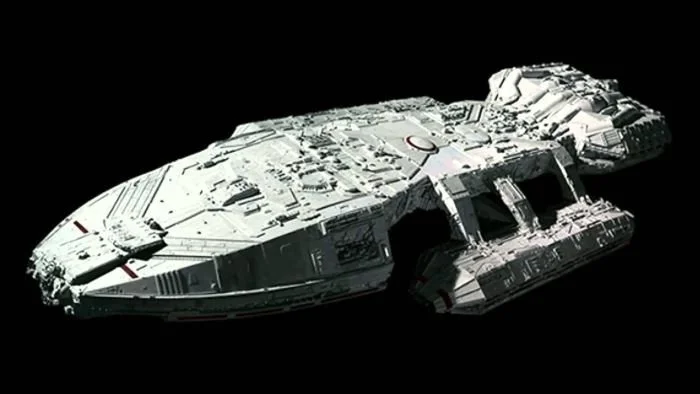'Star Wars' Sued This Franchise Over An Injured Droid
The rivalry between Star Wars and Star Trek is legendary (and nowadays more or less a thing of the past), but back in the late 1970s and early 1980s, there was another skirmish around fictional things happening in outer space aside from Han Solo vs. James T. Kirk or the USS Enterprise vs. the Millennium Falcon. This time it was Twentieth Century Fox against Universal Pictures and George Lucas against Glen A. Larson. Star Wars vs. Battlestar Galactica.
May 25, 1977 changed cinema forever. In the wake of the massive success of Star Wars, many other studios tried to move their own science fiction and space projects forward. Paramount was starting to work on the first theatrical adventure. A guy named Glen A. Larson, who had been active as a writer and director since 1966 (and who would later invent series like The Fall Guy, Magnum P.I., and Knight Rider) reminded Universal Pictures of a story he had pitched to them in the 1960s called Adam’s Ark about a group of scientists who left Earth to avoid a looming apocalypse. Back then, not many studios, including Universal had shown interest in Larson’s story, but now everything changed quickly thanks to Star Wars.
RELATED:
Larson picked up some ideas from his original story and remade it into something called Galactica: Saga of a Star World. He worked on a massive script of 500 pages about a small group of freedom fighters who were hunted by a tyrannical empire. Sensing that the story bore massive similarities to Star Wars, Universal sent the script to George Lucas for approval. The director wanted several changes like omitting “Star World” from the title, not having characters named Starbuck and Skyler, or calling robots droids. Ultimately, Universal just removed “Star World” from the title, but refused the rest of Lucas’ requests.
Lucas would have this say about what became Battlestar Galactica:
“People felt something like Battlestar Galactica was a television version of Star Wars; it was the same thing and they tried to sell it like it was the same thing, as if I had made it. Not only does it upset me because I didn’t think the quality was very good, but it also upsets me because, if I wanted to do a TV series of Star Wars, I couldn’t. They’ve already spoiled the television market.”
Part of Lucas’ frustration might come from the fact that after the release of Star Wars, many of the people who had worked with him left to join the Galactica project like Joe Johnston, Ralph McQuarrie, and John Dykstra (the genius whose revolutionary Dykstraflex had made the creation of the final space battle over Yavin IV possible in the first place). While many returned to Lucasfilm or ILM to work on The Empire Strikes Back (with the exception of Dykstra with whom Lucas had a fallout), it still felt like a betrayal. Also Universal used much of the (lent out) technical equipment that had been created by ILM and The Empire Strikes Back producer Howard Kazanjian had to go through some trouble to get it back.
On December 8, 1977, Fox lawyers sent a letter to MCA, the parent company of Universal, asking them to halt production of Battlestar Galactica, which they refused. Then, in June of 1978, three months prior to the premiere of the 148-minute pilot of Battlestar Galactica that had cost a massive $7 million, Fox finally filed a lawsuit against MCA, Universal, and ABC for infringing upon Star Wars’ copyright.
To prove their point, they laid out 34 instances in which Galactica had ripped off Star Wars. Some of these claims were very general:
“The central conflict of each story is a war between the galaxy's democratic and totalitarian forces”
“Space vehicles, although futuristic, are made to look used and old, contrary to the stereotypical sleek, new appearance of space-age equipment.”
“An entire planet, central to the existence of the democratic forces, is destroyed.”
Other claims were ridiculously detailed:
“A friendly robot, who aids the democratic forces, is severely injured (Star Wars) or destroyed (Battlestar) by the totalitarian forces.”
“There is a scene in a cantina (Star Wars) or casino (Battlestar), in which musical entertainment is offered by bizarre, non-human creatures.”
“A leading character returns to the family home to find it destroyed.”
In order to succeed, Fox’s lawyers would have to prove three things:
That the elements at issue were original to them.
That those elements qualify for copyright protection.
That Battlestar Galactica copied those elements.
While point 3 was relatively easy to prove (with Galactica’s Viper snub-fighters looking quite like X-Wing starfighters, Cylons that were more or less just chrome stormtroopers, and Dirk Benedict’s roguish flyboy attitude that was so close to Luke Skywalker, to name a few), Fox failed to make their case in points 1 and 2. After all, conflicts between a totalitarian system and a small group of rebels have been part of literature and movies for ages before Star Wars. Furthermore, Lucas’ saga was not the first movie to include friendly robots.
So, on October 2, 1980, U. S. District Judge Irving Hill dismissed Fox’s case and on May 8, 1981, MCA and Universal’s countersuit was thrown out as well. Then, in early 1983, shortly before the release of Return of the Jedi, the U. S. Court of Appeals ruled that Fox’s case “should be settled in a courtroom.” Universal’s president Sid Shineberg tried to convince Lucas to just let the matter be, to which the director answered:
“No, it’s not over. We’re settling—when you pay off.”
Ultimately, the case was settled out of court in March 1984. Ironically, by that time Battlestar Galactica had long vanished from television. The last of the 24 episodes had aired on April 29, 1979 after just one season, followed by the ill-fated Galactica 1980, which ran for only 10 episodes. A much darker and gritter Battlestar Galactica (BSG) reemerged in 2003 helmed by Ronald D. Moore. The new series had hardly any similarities with Star Wars at all.
In the following years, George Lucas would talk about the dozens of scripts for his Star Wars live-action series that he could not make because the technology was not there yet to make such a project financially feasible. BSG would then be brought up as an example that it is possible to produce high-quality sci-fi for the small screen at a reasonable budget. Of course, there is now another connection between the galaxy far, far away and Battlestar Galactica. Katee Sackhoff, who played Lieutenant Starbuck in the 2003 version is now portraying the Mandalorian Bo-Katan both in animation and live-action.
READ NEXT:






